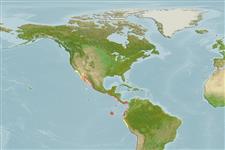>
Carangaria/misc (Various families in series Carangaria) >
Polynemidae (Threadfins)
Etymology: Polydactylus: Greek, poly = a lot of + greek, daktylos = finger (Ref. 45335).
More on authors: Lay & Bennett.
Environment: milieu / climate zone / depth range / distribution range
Ökologie
seewasser; brackwasser demersal; tiefenbereich 10 - 60 m (Ref. 91172). Subtropical; 37°N - 12°S, 122°W - 77°W (Ref. 57343)
Eastern Pacific: Monterey Bay, California, USA to Callao, Peru. One record from the Galapagos Islands. Rare north of Baja California, Mexico (Ref. 2850). Record from Chile (Ref. 9068) needs to be verified (Ref. 57343).
Size / Gewicht / Alter
Maturity: Lm ? range ? - ? cm
Max length : 36.8 cm TL Männchen/unbestimmt; (Ref. 115882); common length : 20.0 cm TL Männchen/unbestimmt; (Ref. 55763)
Rückenflossenstacheln (insgesamt): 9; Rückenflossenweichstrahlen (insgesamt): 11-13; Afterflossenstacheln 3; Afterflossenweichstrahlen: 13 - 15; Wirbelzahl: 24. Body grayish, no stripes or spots. Lip on lower jaw well developed. Dentary teeth restricted to dorsal surface. Maxilla not covered with scales. Pectoral filaments 6; longest not reaching beyond level of posterior end of anal fin base. Lateral line bifurcated on caudal fin membranes, extending to posterior margins of upper and lower caudal fin lobes. Swim bladder present (Ref. 45049).
Found in shallow water near the coast, on sand and mud bottoms (Ref. 9332). Larvae and small juveniles (>4 cm) are pelagic and sometimes occur several hundred kilometers offshore, whereas the larger juveniles and adults prefer shallow near-shore waters like bays, sloughs or estuaries where the bottom is sandy or muddy (Ref. 28023). Omnivorous, feeds on worms, sand crabs, shrimp, clams; sometimes feeds on fish like small anchovy (Ref. 28023). Esteemed food fish where it occurs (Ref. 57343). Also Ref. 55763.
Life cycle and mating behavior
Geschlechtsreife | Fortpflanzung | Ablaichen | Eier | Fecundity | Larven
Motomura, H., 2004. Threadfins of the world (Family Polynemidae). An annotated and illustrated catalogue of polynemid species known to date. FAO Spec. Cat. Fish. Purp. Rome: FAO. 3:117 p. (Ref. 57343)
IUCN Rote Liste Status (Ref. 130435)
Bedrohung für Menschen
Harmless
Nutzung durch Menschen
Fischereien: kommerziell
Mehr Information
NamenSynonymeMetabolismusRäuberÖkotoxikologieFortpflanzungGeschlechtsreifeAblaichenSpawning aggregationFecundityEierEientwicklung
ReferenzenAquakulturAquakultur ProfilZuchtlinienGenetikElectrophoresesVererbbarkeitKrankheitenVerarbeitungNutrientsMass conversion
PartnerBilderStamps, Coins Misc.LauteCiguateraGeschwindigkeitSchwimmstilKiemenoberflächeOtolithsGehirngrößeSehfähigkeit
Tools
Zusatzinformationen
Download XML
Internet Quellen
Estimates based on models
Preferred temperature (Ref.
123201): 20.5 - 29, mean 25.9 °C (based on 273 cells).
Phylogenetic diversity index (Ref.
82804): PD
50 = 0.5000 [Uniqueness, from 0.5 = low to 2.0 = high].
Bayesian length-weight: a=0.00646 (0.00433 - 0.00962), b=3.06 (2.94 - 3.18), in cm total length, based on LWR estimates for this species & Genus-body shape (Ref.
93245).
Trophic level (Ref.
69278): 3.6 ±0.6 se; based on diet studies.
Widerstandsfähigkeit (Ref.
120179): hoch, Verdopplung der Population dauert weniger als 15 Monate. (Preliminary K or Fecundity.).
Fishing Vulnerability (Ref.
59153): Low to moderate vulnerability (27 of 100).
Nutrients (Ref.
124155): Calcium = 101 [51, 203] mg/100g; Iron = 1.13 [0.58, 2.10] mg/100g; Protein = 20.2 [18.6, 21.8] %; Omega3 = 0.402 [0.275, 0.617] g/100g; Selenium = 24.2 [12.8, 48.0] μg/100g; VitaminA = 9.48 [3.93, 22.61] μg/100g; Zinc = 0.904 [0.619, 1.327] mg/100g (wet weight);
